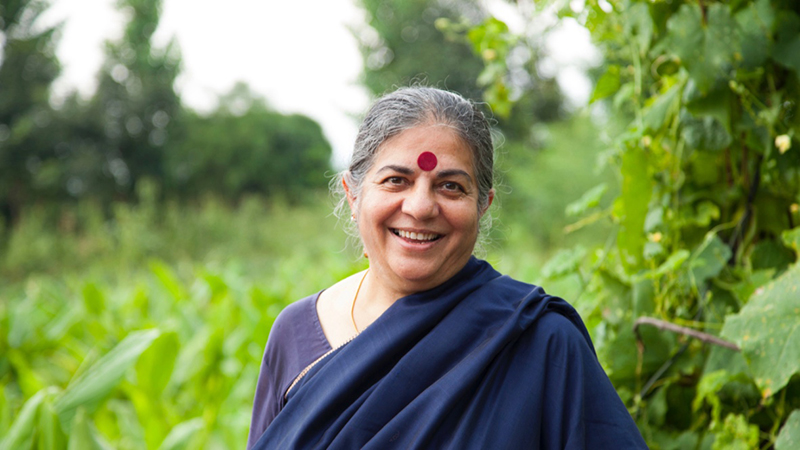
Dr. Vandana Shiva was born in the forests of the Indian Himalayan Region, her father a forester and mother a farmer. “I literally grew up between the forest and the farm,” she says. “That was my childhood–there was continuity between the forest and the farm because we worked with biodiversity.” But as she grew up, she learned that there were entities actively breaking that continuity. Right before moving to Canada to pursue her PhD in quantum physics, Dr. Shiva journeyed on a trek through her beloved Himalayan forests. “I found a forest that had been familiar to me, and it was gone, and the stream there was just a trickle,” she says. “That’s what really woke me up to the destruction of nature.” It was a moment that set her on a decades-long path as an activist and food sovereignty advocate where her passion for the harmony of the natural world and her interest in science emerged.
Dr. Shiva could not get that decimated forest out of her mind. On the outset of her travels to Canada, while waiting to catch her bus to the airport, she was talking to a chaiwala—tea vendor—at the stop and he mentioned the Chipko movement. “Chipko, which means ‘hug,’ is a movement from the women of my region [Uttarakhand] who protected trees by saying that they were going to hug them,” she says. The Chipko movement was a 1970s women-led non-violent collective action fight against the government’s policies that allowed industry to clear-cut forests. Forest destruction led to floods and landslides that destroyed farms. Out of necessity for survival, women of the region–who were traditionally charged with cultivation and livestock–banded together to form the Chipko movement which eventually grew to international renown. After that initial introduction to the movement, Dr. Shiva returned to India every school break to work with Chipko. “That’s what moved me into my activism, my ecological learning, my biodiversity learning,” she says. “I always say my professors were the trees and the women of Chipko.”
This lesson from the rural people around her began to meld with her passion and interests in science. “I had very peacefully studied physics and I had no idea that the world was being transformed by very powerful players,” she says speaking of The World Bank, development agencies, and Monsanto (now Bayer), an agrochemical and agricultural biotechnology company criticized by environmentalist and farmers for the environmental impact of their fertilizers and pesticides and their tight monopoly-like hold on seed production.
As she studied science–inspired by Albert Einstein’s writings on science and society–she also learned about chemical agriculture and The Green Revolution, which describes the period of science and technology advances to increase agriculture crop yields. "Big Ag" can be traced back to this revolution as it led to industrialized agriculture practices. This led Dr. Shiva to publish “The Violence of the Green Revolution” in 1991 (and reprinted in 2015). The Green Revolution had previously been lauded as transformational. The man behind the movement, Norman Borlaug, was even awarded the Nobel Peace Prize in 1970–but scholars like Dr. Shiva began to show how devastating large-scale agriculture was for small farmers and the environment. She has dedicated nearly five decades to ecological and environmental activism and has published dozens of books that showcase her own evolution. She has received accolades and awards such as the 1993 Right Livelihood Award (commonly referred to as the "Alternative Nobel Prize"), The UN Global 500 Award, and an Earth Day International Award.
One concept that Dr. Shiva emphasizes is non-violent farming practices which contrasts to the connection she makes between large-scale agriculture and the violence of war. She demonstrates this association in two ways: first, the chemicals and pesticides used in fertilizer for large-scale agriculture are often the same ones used in warfare, and second is the existential violence perpetrated by stripping the land of its biodiversity in the name of monoculture. “Allowing diversity to thrive is the non-violence,” she says. And she sees all of this interconnected with the individual health of human beings.
“All of this [work around the Green Revolution] was done in the name of feeding the world,” she says. However, there were ripple effects with negative consequences for social justice. “The same systems that are unsustainable have to exploit migrant labor and/or destroy our health [in the name of larger crop yields].” The impetus behind the Chipko movement is an example of movements that seek to counter practices that harm both people and the planet. It all comes down to seeing the interconnection between social justice and health, themes that Dr. Shiva will focus on in her plenary talk for UC Global Health Day.
“I want to show that there’s one health,” she says. “The health of the planet and our health is the same. The health of the plants and our gut is the same health. One, indivisible health. That is ecological health, the health of justice. That health is of diversity working together.”
